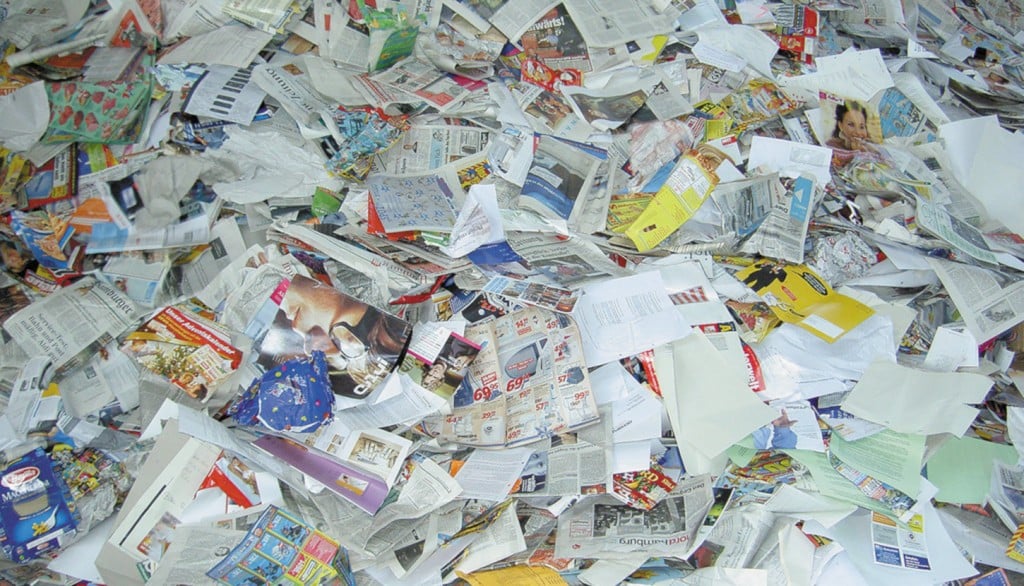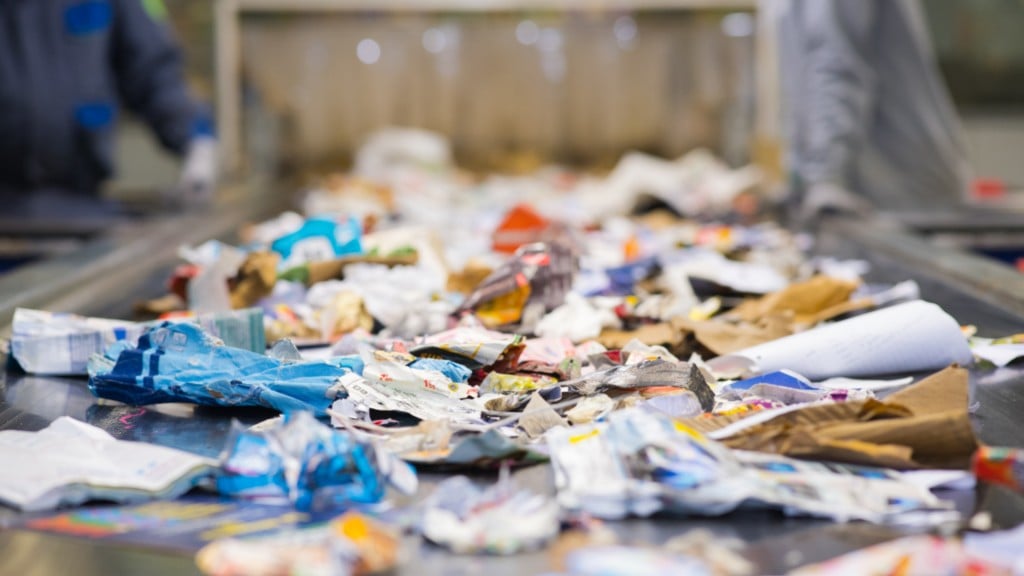Surviving the changing mixed paper market
Global market swings require a rethink on how MRFs sort and separate mixed fibre streams

In the last several years, North American recycling operations have seen overseas markets for fibre products that have historically been reliable become much more difficult to access. Rising global purity standards are either virtually unobtainable using traditional sorting and separation methods, or they are too costly to meet using options such as adding additional manual sorters.
China's National Sword and Blue Sky policies since 2017 have effectively closed the door of the world's largest purchaser of recovered paper. And it was just the beginning.
"Markets like Indonesia, India and Japan are all following China's example and demanding the same high purity standards for recycled material," explains Nick Doyle, recycling area sales manager west North America for TOMRA Sorting Recycling. He says the result is high supply, low demand and a market saturated with recovered fibre.
This has driven down the price of key MRF fibre products including mixed paper and corrugated boxes (OCC). Mixed paper now consistently sells at a negative value or zero (at best) U.S. dollars per ton in most markets, while OCC is trading at the lowest levels seen in a decade.
"It's the simultaneous drop of both commodity prices that is hurting MRFs," says Dan Gee, senior associate with Moore & Associates, an Atlanta, Georgia-based consulting firm specializing in the paper recycling industry.
Market indicators show this being more of a long-term industry trend, rather than a short dip in the market.
"There is no quick fix for mixed paper," Gee adds. "Most estimates are it will take a minimum of two or three years, possibly longer, for mixed paper to recover, and recycled paper quality required from MRFs will increase."
Gee says MRFs are handling these current market challenges in several ways. Some are renegotiating contracts with their municipal customers, if possible. Others are simplifying what recyclable material they will accept, while some are returning unmarketable material to the landfill. Some domestic buyers are not accepting any paper, while others are biding their time and hoping for a market rebound.
Better sorting, higher value
The United States recycles roughly 58 million tons of fibre products annually. (In Canada, according to Environment Canada, paper and fibre products account for more than 1/3 of all Canada's waste, with approximately 6 million tonnes of paper and paperboard recycled annually.)
With MRFs processing high volumes of fibre daily, sitting back and waiting for a market rebound could be a costly strategy.
"My customers tell me roughly 70 to 75 percent of their volume received is fibre - cardboard, newspaper, office paper, etc.," comments Doyle. "Most of the material inflow is sorted into products the operation either has to pay someone to take, or the value is a fraction of what it has been.
"MRFs must start looking at sorting their paper differently. While there isn't money in mixed paper, there is money if this commodity is further separated," he says.
Mark Neitzey, director of sales for Van Dyk Recycling Solutions, a specialist in turnkey sorting systems based in Stamford, Connecticut, tells his customers to examine the market from a supply and demand angle.
"Say you run a soup business, and for years your customers wanted this one soup recipe. It was your cash cow," Neitzey explains. "Unfortunately, demand for that recipe has vanished, but there are opportunities for you to switch to other recipes and make more money.
"What would the company do?" he asks.
"Think of mixed paper as the mirror image of being ‘greater than the sum of its parts,'" adds Doyle. "Mixed paper sorted into individual components can result in much more revenue for the MRF, measured in the thousands of dollars per day."
Focus on products in demand
To survive, MRFs must rethink their approach to their recycling streams and shift practices to focus on making more profitable products that are in demand.
"One MRF manager in the southwest put it well when he said, ‘We are no longer in the business of making commodity grades. We are in the business of making products,'" relates Doyle.
Even without plant modifications or adding new sorting technology, shifting focus to a product vs. commodity mentality can help MRFs pull more OCC from mixed paper, for example, which will increase profitability. Estimates show approximately 40 percent of North Americans shop online multiple times monthly, resulting in the "Amazon Effect," by which a significantly higher percentage of smaller OCC ends up in single-stream recycling.
"We are not seeing as much large cardboard in single stream anymore," comments Neitzey. "Virtually everything comes in boxes today, so there are a lot of small boxes and chip board in the stream."
Doyle agrees, "Many existing MRF sorting systems were designed to remove the larger cardboard boxes. Since small boxes act like paper, more cardboard and chipboard will end up in mixed paper. Further sorting mixed paper to remove the OCC will help to boost profitability."
Moore & Associates' Gee mentions that a trend for some MRFs currently is to produce a sorted residential papers and news product (SRPN-PSI #56) from their residential paper stream, rather than from their mixed paper stream. SRPN consists of newspaper, junk mail, magazines, printing and writing paper, as well as other acceptable paper coming from residential material. Depending on the region, this "new" newspaper grade currently commands upward of U.S. $55 per ton.
Intelligent, high-tech Separation
MRFs also have the option to invest in high-tech sorting technology to further sort mixed paper contents and substantially improve sorted fibre revenue streams. Cognizant of today's market trends and tightening purity standards, optical sorting equipment manufacturers, such as TOMRA Sorting Recycling, have responded with a new generation of technological advancements to meet the sorting needs of today's MRFs.
While robotics is the hottest topic in the recycling industry currently, Van Dyk's Neitzey notes that savings from replacing manual sorters with robots can only go so far.
"While upgrading existing circuits is not as flashy as robotics, investing in intelligent separation through upgraded technology and rethinking sorting practices have the potential of saving the MRF hundreds of thousands of dollars a month in lost revenue," he says.
For example, the introduction of laser-based sorting technology within the last year promises to help deliver cleaner paper products like SRPN. Most MRF sorting systems include near infrared (NIR) technology to either positively or negatively sort paper. "NIR works great for sorting newspaper, white paper, magazines, PET bottles, milk jugs, etc." comments Neitzey. "However, this technology cannot see the black plastic bowl from a to-go container, or glass on the belt, allowing some of this material to end up in SRPN as impurities or prohibitives."
Laser-based sorting technology, such as TOMRA's Laser Object Detection (LOD), was designed specifically to identify and remove these traditionally hard-to-see materials from the paper stream, helping MRFs to pass a mill customer's sight-test.
"Since LOD detects items like black plastic and glass that NIR cannot see, combining LOD technology with our AUTOSORT system gives MRFs the ability to produce a cleaner paper product that meets today's purity standards," says Carlos Manchado Atienza, regional director Americas for TOMRA Sorting Recycling. "It can be installed as an add-on to an existing line to minimize investment cost or it can be a stand-alone unit on a new circuit."
SOP may be the key
Commanding over U.S. $100 per ton domestically and much more in certain markets, sorted office paper (SOP) may be the key to helping MRFs survive today's mixed paper market. This product consists primarily of white and coloured groundwood-free paper, free of unbleached fibres, and cannot contain more than one percent prohibitive materials, with outthrows plus prohibitives not exceeding five percent.
SOP can be separated from residential paper, but there is a catch. Unless the MRF has contracts with businesses or receives shredded paper, the percentage of white paper found in single stream can be limited, and it is market dependent.
"MRFs operating in a place like Boulder, Colorado, which has a high telecommute population, will tend to find more paper fitting the SOP parameters than those operating in urban areas," explains Neitzey.
Still, Doyle is a strong proponent of MRFs making the effort to sort out their SOP product and to consider changing business practices toward taking in more white paper.
"Say the MRF receives U.S. $148 per sorted ton of SOP," he says, "but is paying $2 per ton to offload mixed paper. That's a $150 per-ton swing toward profitability."
The next generation of optical sorting technologies available also aid in separating office-grade from mixed paper.
TOMRA's latest upgrade to the AUTOSORT system, called SHARP EYE, peers through paper into its molecular makeup to provide a cleaner paper sort.
"SHARP EYE can look through the colour to see if the fibres are completely dyed or if the paper is just colour-coated with a white base," explains Doyle. "It is capable of sorting the fully coloured fibres from the white paper wanted in an SOP clean product sort."
The latest TOMRA sorting technology also includes a larger, high-resolution lens not available on previous versions.
"We now offer customers the flexibility to choose between the standard resolution for regular sorting, and a high-resolution package, with SHARP EYE for sorting different products, including office paper that meets purity standards," says Doyle.
Manchado Atienza agrees and stresses to customers that purity is critical with sorting. "Classification volume is important, but without detection precision, the investment is useless."
Neitzey also advises customers who want to separate out office paper that tipping floor management is a very important aspect to consider. "Blending everything together on the floor will reduce the amount of white paper an operation can separate from the mixed paper," he says. "It's best to sort out as much of the white paper as possible on the floor. Some customers currently do this and dedicate two or three days a week for sorting office paper."
While targeting high-value products within the fibre stream isn't new, the consequences of not doing so within the confines of today's market conditions may be the difference between profitability and survival for MRF operators.
"Fibre is also the most labour-intensive process to which there is no financial gain, given today's mixed paper market plus labour costs," concludes Doyle. "If MRFs continue to ‘weather the storm' by increasing labour and decreasing throughput to make a negative-value product, I fear by the time mixed paper rebounds, we will have already lost much of our recycling infrastructure."
However, he emphasizes, with equipment manufacturers now offering market-proven paper sorting technology advancements, such as LOD and SHARP EYE, the resources are available for MRFs to use the demand for purity and product diversity to their advantage. RPN
President of Z-Comm LLC, Rick Zettler is an Iowa-based writer, photographer and award-winning PR & marketing consultant.
This article was originally published in the September, 2019 edition of Recycling Product News, Volume 27, Number 6.
Company info
8935 Ridgemont Drive
Atlanta, GA
US, 30350
Website:
marecycle.com
Phone number:
770-518-1890





